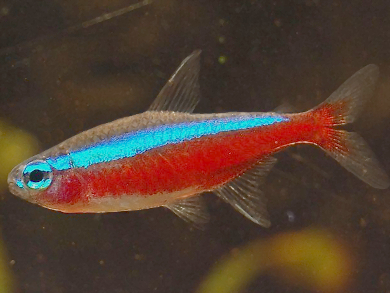Light-Induced Color Change in the Skin of the Neon Tetra Fish
The neon tetra fish from the Amazonas River, along with some reptiles, amphibians, and other fish, takes advantage of structural colors in its skin to change its appearance in response to a triggering signal. In the light-adapted state, its lateral stripe shimmers blue-green, in the dark it is indigo. Scientists from Israel have now found an unambiguous answer to how this intriguing mechanism works. They present their results, which favor the so-called “Venetian blind” model, in the journal Angewandte Chemie.
Tilting of Guanine Crystal Arrays is Key
The “Venetian blind” model proposes a light-triggered tilting of layers of guanine crystals in the skin cells, but the other model, the “accordion” model, considers osmotic swelling of the cytoplasmic layers as the only cause for the color switch. Both models would lead to variations in the spacings between the crystals, resulting in a color change. So, which of the two models holds?
The team of Lia Addadi and Steve Weinerl, Weizmann Institute of Science, Rehovot, Israel, and Peter Fratzl and his team, Max Planck Institute of Colloids and Interfaces, Potsdam, Germany, used microspot X-ray diffraction to investigate the behavior of the cells in physiologically active skin of the lateral stripe of neon tetra under both light or dark regimes. An unambiguous shift in the diffraction spots was observed upon changing the light conditions, demonstrating that crystal tilting was the main cause of the light-triggered color switch, validating the “Venetian blind” model.
Biocompatible Color-Changing Materials
With the “Venetian blind” mechanism confirmed, the scientists are currently trying to gain deeper insight into the light-triggered mechanism, as possible applications of the color-changing guanine crystal systems are vast. Dvir Gur, co-author of the publication, says: “Since guanine crystals are nonhazardous and biocompatible, they are widely used in the cosmetic industry … [They] provide pearlescent effects in products such as nail polish, mascara, and makeup”. Imagine an eye shadow, for example, that switches its color when moving from sunlight into artificial light! And besides decorative purposes, optical applications such as in band-pass filters and other industrial material can be envisaged as well.
Regarding possible engineering, Gur says: “Mimicking the fish strategy will require a design that is capable of changing the spacing between the guanine crystals … Fixing the guanine crystals at only one end will induce tilt changes in a manner similar to the one observed in the neon tetra system.” Thus, the neon tetra fish and its handling of guanine crystals may serve as a valuable resource for nature-inspired new materials.
- The Mechanism of Color Change in the Neon Tetra Fish: a Light-Induced Tunable Photonic Crystal Array,
Dvir Gur, Benjamin A. Palmer, Ben Leshem, Dan Oron, Peter Fratzl, Steve Weiner, Lia Addadi,
Angew. Chem. Int. Ed. 2015.
DOI: 10.1002/anie.201502268




